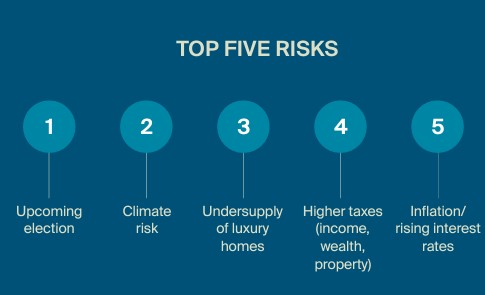The 2024 outlook for the luxury property market is mixed, as prime price growth is revised upwards, headwinds may be easing, but several key risks remain ahead.
According to Knight Frank’s Global Prime Residential Forecast, the projections for prime prices in 2023 and 2024 have been revised upwards. The 2023 forecast was initially 1.7%, revised to 2.4%, while 2024 was initially 2.1%, now 2.5%.
The factors set to shape 2024
The tumultuous 2023 has been characterised by global conflict, soaring inflation and interest rates, and general uncertainty.
But among the expectations for 2024, the report found headwinds may be easing, the proportion of cash buyers rising, and elections are the biggest risk to prime markets for next year.
The report found that cash sales rose from 46% to 52% in the last six months.
Politics and regulations are both a major hurdle and potential boon. On the one hand, tighter controls around energy, sustainability, and holiday letting may be concerns going into 2024, but on the other hand, relaxation of property and tax regulations may be an opportunity.
Upcoming elections include the Indian General Election (before the end of May 2024), US Presidential Election (November 2024), UK General Election (before January 2025), Canadian General Election (Before October 2025), and Singaporean General Election (before November 2025).
The report also found that the increase in demand is expected to be small, likewise the increase in supply, sales, and foreign buyer activity.
Melbourne and Sydney in top ten for price growth forecast
The Sydney luxury property prices are forecasted to rise five per cent next year, fifth behind Auckland, Mumbai, Dubai, and Madrid.
Melbourne came in at eighth in the world, with prime residential property prices predicted to increase by three per cent.
Perth and the Gold Coast are also forecast to see luxury homes rise in value, up four per cent each.
| City | Forecast prime residential price growth 2024 |
| Sydney | 5% |
| Perth | 4% |
| Gold Coast | 4% |
| Melbourne | 3% |
| Brisbane | 3% |
Source: Knight Frank Research.
Knight Frank head of residential research in Australia, Michelle Ciesielski, said cautious optimism was emerging in the luxury residential property market globally, with prime buyers appearing confident that economic headwinds were easing.
“In Australia, buyer appetite is strengthening, while supply of prime properties is constrained,” she said.
“The limited number of exceptional and most desirable prime residential property listings continues to create a price floor under many luxury Australian properties.
“This undersupply of luxury homes is one of the key factors set to shape the performance of the Australian prime residential market in 2024, with inflation and interest rates also set to play a big role.”
Michelle Ciesielski, Knight Frank
“In saying that, in this upper echelon of the market, we are seeing an increasing number of cash buyers, with the proportion being 60% of all prime residential property sales in Sydney and 65% in Melbourne.
“Climate risk, geopolitical tensions and currency shifts are also expected to impact the Australian luxury property market.
“Amongst these risks there are opportunities, however, with property set to continue to appeal as a means to diversify and spread risk, being seen as a safe haven for capital.”
Knight Frank head of residential in Australia, Erin Van Tuil, noted that the super-prime end of the market, especially A$20 million plus, is doing exceptionally well, with no shortage of buyers and limited homes.
“Most buyers are local Australian buyers, with a notable absence of foreign buyers committing to sales, despite enquiries.
“Relative to other Australian cities, Melbourne has counted more prime luxury product built over the past couple of years, which has made prime prices lag the stronger performance in other Australian cities.
“Melbourne is also still recovering from an extended lockdown in the pandemic, with the city seeing many residents move interstate to Queensland and the slower return of international investors which the city relies heavily on.”
Source : ThePropertyTribune


